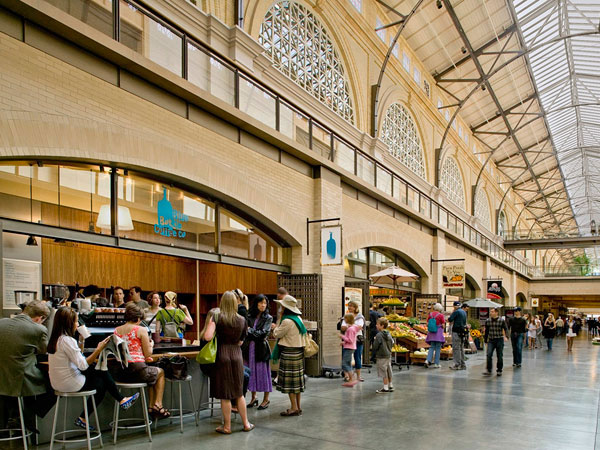Ferry Building: San Francisco, California

Summary
The restored Beaux Arts-style Ferry Building, once described as "a famous city's most famous landmark," is the quintessential picture of elegance with a 660-foot-long skylit nave and 245-foot-tall clock tower inspired by the 12th century bell tower in Spain's Seville Cathedral.
Designated Area
Located at the intersection of Market Street and the Embarcadero at 1 Market St.

At the time of its construction in 1898, the Ferry Building's steel-frame foundation was the largest for a building over water in the world. The Oakland Bay Bridge can be seen in the background. Photo courtesy of Morgret.
Planning Excellence
The restored Beaux Arts-style Ferry Building, once described as "a famous city's most famous landmark," is the quintessential picture of elegance with a 660-foot-long skylit nave and 245-foot-tall clock tower inspired by the 12th century bell tower in Spain's Seville Cathedral.
During the 1930s, at the height of its use, 50,000 people entered the depot each weekday, making it the world's second busiest terminal, trailing only Charing Cross Station in London. With the opening of the Oakland Bay Bridge in 1936 and the Golden Gate Bridge in 1937, ferry ridership declined precipitously as workers and visitors from the east and north began driving into the city.
Another change pushing the building towards obsolescence was construction of the double-decker Embarcadero freeway in 1957 that left only the clock tower of the building visible. Offices filled in the large open hall, and its beautiful mosaic floor was covered up.
The Embarcadero freeway was damaged in 1989's Loma Prieta earthquake and demolished in 1991, opening a new chapter for the depot.
Collaborating on a 10-year, $110 million renovation were former Mayor Willie L. Brown, Jr., Equity Office Properties, Wilson Meany Sullivan, and the Port of San Francisco. To attract visitors, the ground floor was styled as a European market place, incorporating ideas from public markets in Paris, Harrods in London, Peck in Milan, and Pike Place Market in Seattle.
Since its reopening in 2003, more than 10,000 commuters a day have used the Ferry Building. Panoramic views of the bay, Treasure Island, and the Oakland Bay Bridge are available from a new wharf. A large, sunny plaza outside the building's southern end accommodates a year-round Farmer's Market. Inside, the building's great hall has been completely restored and includes restaurants, historic galleries, and places to sit and enjoy the waterfront. "It's not just an icon anymore," said San Francisco Planning Director Byron Rhett. "People are using the building again."

Once used as storage areas for ferry service, the 660-foot long nave is now a main public promenade showcasing local food shops. Photo courtesy of David Wakely.
Defining Characteristics, Features
Historical Significance
- Designed by architect Arthur Page Brown to replace an 1875 wooden Ferry House; steel-framed foundation is the largest for a building over water in world; first scheduled ferry service began July 1898
- The 245-foot clock tower houses the largest wind-up mechanical clock in the world; dials are 22 feet in diameter; electric motors are now used to move hour and minute hands
- Steel structure survived 1906 and 1989 major earthquakes with little damage
- Listed in 1977 as City of San Francisco historic landmark; added to the National Register of Historic Places in 1978
- Before renovation, San Francisco Chronicle columnist Herb Caen wrote that the building was "a famous city's most famous landmark"
Mixed-Use Vision and Plan
- The farmers market, located on a makeshift parking lot outside of the building after the freeway was removed, became popular and helped inspire decision not to rebuild the freeway and to restore the Ferry Building to its former greatness
- Planned as mixed-use development with world-class food market
- Port of San Francisco selects the joint venture between Equity Office Properties and Wilson Meany Sullivan, and a design team involving three local architectural firms to redevelop building
- Chris Meany, a developer involved with revitalization, says building "one of the most important and dramatic interior spaces in the western U.S."
Renovations
- Bay waterfront revitalization begins in 1998 with Ferry Building as the main focus
- Renovations include complete seismic and structural retrofit; re-creation of 660-foot-long Great Nave skylight, 11 monumental brick and terracotta arches, 34 clathri windows each 11 feet tall; 12 steel arched trusses, 35 other arches restored
- First floor provides 65,000 square feet of space including eight restaurants and cafes with both indoor and outdoor seating, more than 30 shops, small building museum; 22,000 square feet of mosaic marble restored on first floor
- Second and third floors provide 175,000 square feet of office space
- Farmer's market features locally grown and produced specialty foods, including fruits, vegetables, cheeses, and wines; open three days a week

Run by the Center for Urban Education About Sustainable Agriculture, the farmer's market features cooking classes and an abundant selection of local produce, cheese, wines, and other foods three days a week. Photo courtesy of David Wakely.


